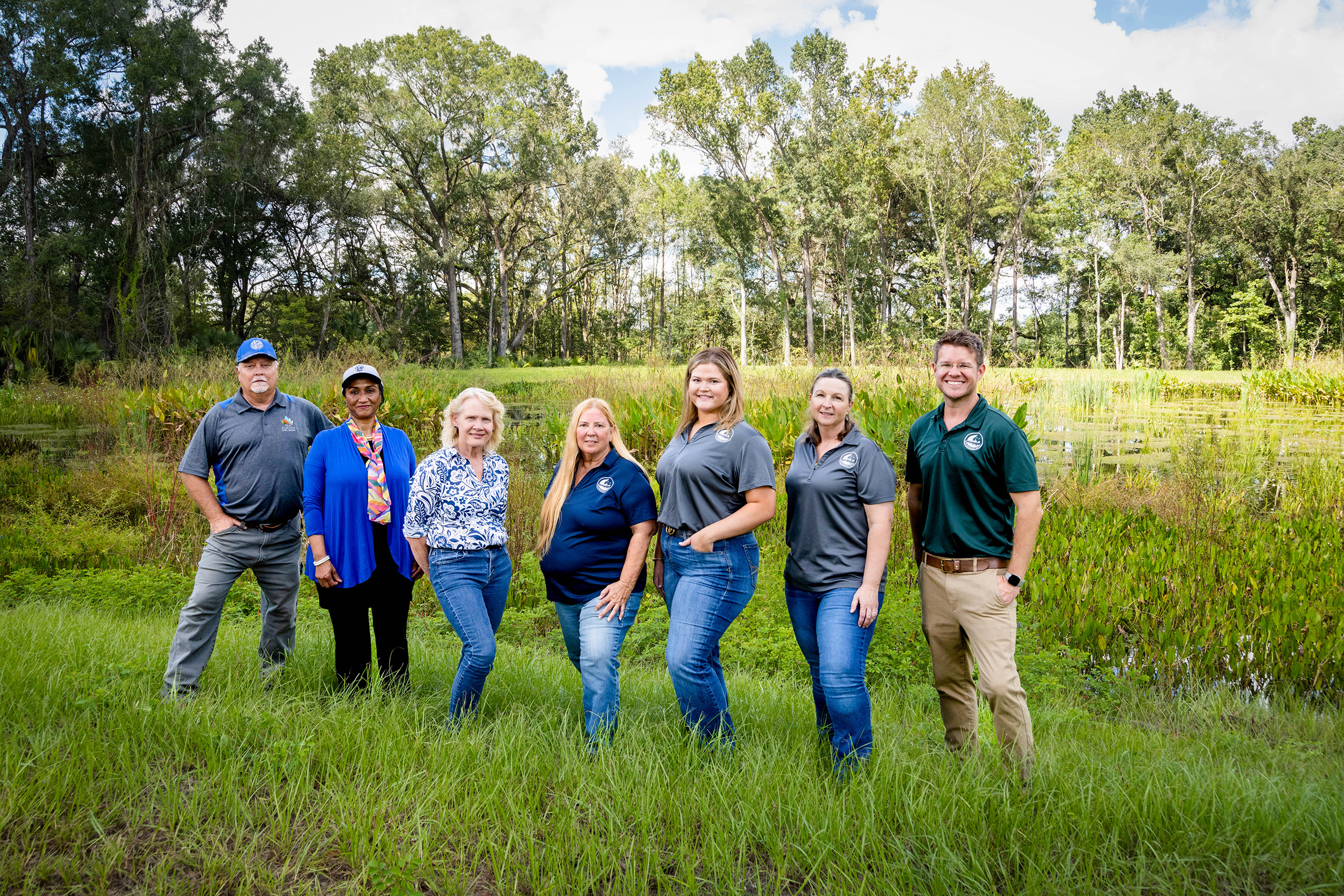Mill Creek Sink: Protecting Florida’s Water System in Unexpected Places
A wetland near Mill Creek Sink, a sinkhole in Alachua County, Fla., is home to a variety of wildlife and native plants. It is active with native birds. One might see white egrets and blue heron wading for food, or a gray tufted titmouse perched atop some pickleweed. Duck potato, bullrush and alligator flag are among some of the other native plants.
“We get a lot of wildlife out here,” said Ted Williams, public services project manager with the City of Alachua. “We’ve seen ducks, native birds, butterflies and dragonflies, and there are deer that come out. When we were doing the build, we saw animal tracks all over the place, so I think they would lay back during the day and come out here in the evenings.”
An Unexpected Location
This wetland is not down a trail off the beaten path. The “build” Williams is referring to is a manmade wetland, part of a stormwater treatment system tucked behind local commercial businesses and filtering runoff from parking lots, I-75 and SR 441. The Mill Creek Sink Water Quality Improvement Project is ultimately helping to preserve and protect local drinking water.
“Driving by this growing, urbanized interchange, you wouldn’t know that, just off the roadway, is a beautiful sink that has many connections to our groundwater and ultimately our springs,” says Hugh Thomas, executive director of the Suwannee River Water Management District (SRWMD). “Ensuring that stormwater is treated and filtered before going back into the aquifer is vital, and this unique water treatment system provides a natural process that helps improve the health of the sink and our water supply.”
The project helps reduce nitrogen in the Santa Fe River Basin (currently considered “impaired” for nitrate-nitrogen) and, ultimately, the Floridan aquifer.

“This area has a lot of stormwater runoff and it goes directly into the Mill Creek Sink,” said Charlene Stroehlen, principal engineer with WSP, a project partner. “The businesses here are older and were built prior to Environmental Resource Permitting rules and regulations. So the stormwater runoff was being discharged directly to Mill Creek Swallet without any water quality treatment.”
Now, plants and grasses help to naturally remove pollutants. The wetland is a collection barrier, giving nature time to slowly filter the groundwater — which travels across impervious surfaces such as roads and parking lots — by instead letting it percolate through loose, sandy soils and porous limestone bedrock.
Because the area is very karst or porous, project partners wanted to make sure they were constructing the wetland in the best possible locations to survive. Two tiers constructed at a higher level collect the stormwater runoff, then the water flows into the third tier: the wetland treatment system on a lower elevation, so wetland plants survive. It then goes into another natural wetland and filters through the rest of the forest. The plants in the wetlands reduce nitrogen loading, suspended solids, and other pollutants before the water reaches the aquifer.
Truly Connected
“The Mill Creek watershed covers 23 square miles,” says Eiman Abbas, water engineer with the City of Alachua. “Mill Creek Swallet serves as a source of recharge to the Upper Floridan aquifer and is connected into the Mill Creek Sink and Cave System.”
The Floridan aquifer is an 82,000-square-mile reservoir holding billions of gallons of the state’s fresh drinking water. Groundwater in the Floridan aquifer is the source of more than 1,000 springs in North and Central Florida and provides water for more than 90% of its residents. A dye tracing study conducted in the cave system in 2005 made clear the importance of cleaning up the water entering the sink.
“Water from Mill Creek Sink and Swallet can reach Hornsby Spring 6.09 miles away in about 12 days,” explains Kris Eskelin, senior project manager for SRWMD. “It was important to reduce nutrient loading, sedimentation and other pollutants to benefit the Santa Fe River and Floridan aquifer and increase habitats for wildlife.”
Nitrogen levels for Mill Creek Sink recorded from 2009 to 2017 ranged from 0.0048 to 7.8 mg/L, with a median value of 1.054 mg/L, which is very high.
A Community Coming Together
The project involved a voluntary public agency effort among Alachua City officials, Alachua County officials, environmental engineers like those at Wood and SRWMD.
In 2016, the City of Alachua applied for and received a $400,000 RIVER (Regional Initiative Valuing Environmental Resources) grant from SRWMD to provide a stormwater treatment pond to protect the Mill Creek Swallet, Sink and Cave System.
The following year, the Florida Department of Environmental Protection (FDEP) awarded an additional $1 million from the Springs and Watershed Restoration Program to provide modeling, land acquisition, and augment the design and stormwater management improvements.
The City of Alachua then submitted the “Mill Creek Sink Water Quality Improvement Project ” to FDEP, and it was included in the Santa Fe River Basin Management Action Plan (BMAP) in June 2018 with the goal of reducing nitrogen by 66%.
In 2021, an additional $645,478 was added to the agreement to complete the construction. Approximately 12 acres were acquired to create storage basins and a wetland for the final polishing of stormwater that exists today.
Effective and Educational
The Suwannee River Water Management District considers this project not only effective in its purpose but educational, helping others understand the connection between stormwater and the source of potable water.
“Future plans may include public access,” added Eskelin. “This is a positive step in addressing the reduction of nutrients and the Santa Fe Basin Management Action Plan and the Hornsby-Treehouse Springshed Priority Focus Area and has the potential to inspire others looking to replicate this in their communities.”
For more information on this and other projects, visit MySuwanneeRiver.com.
